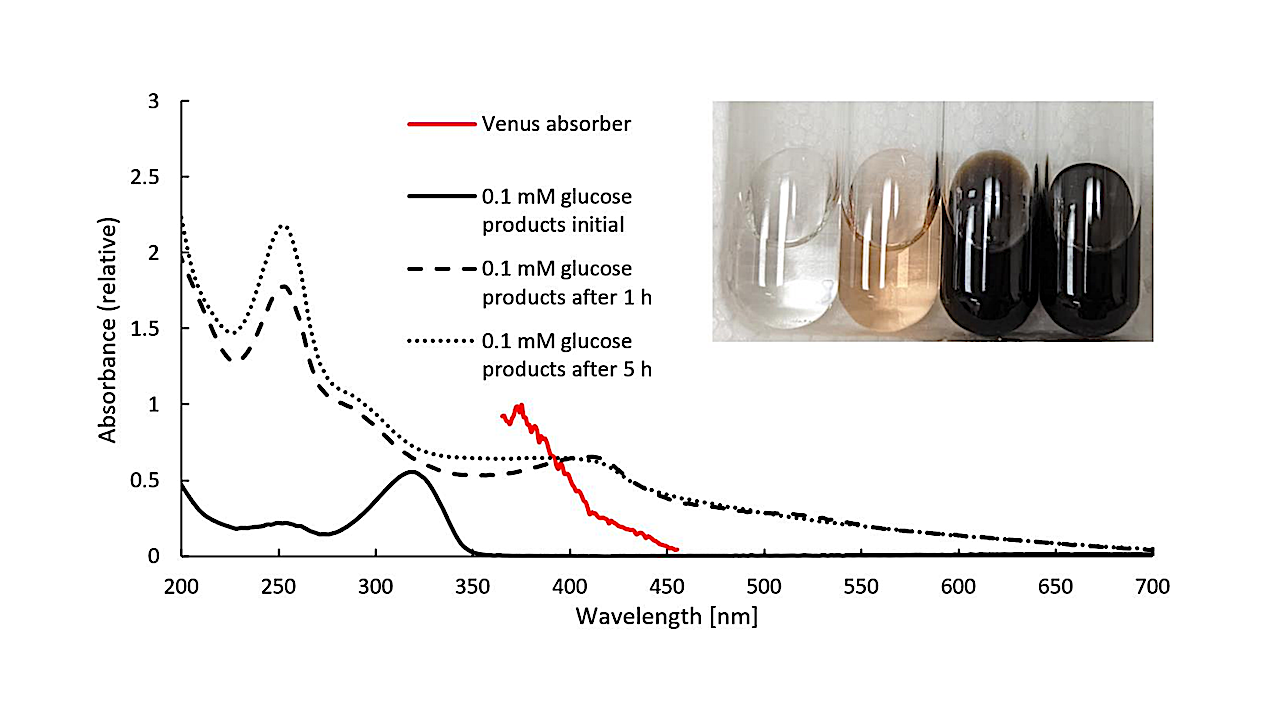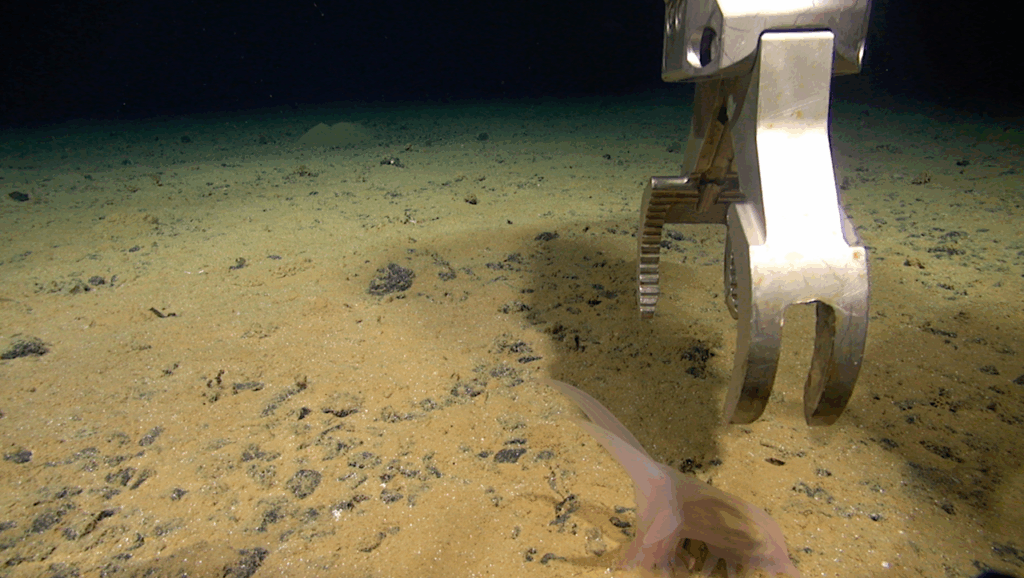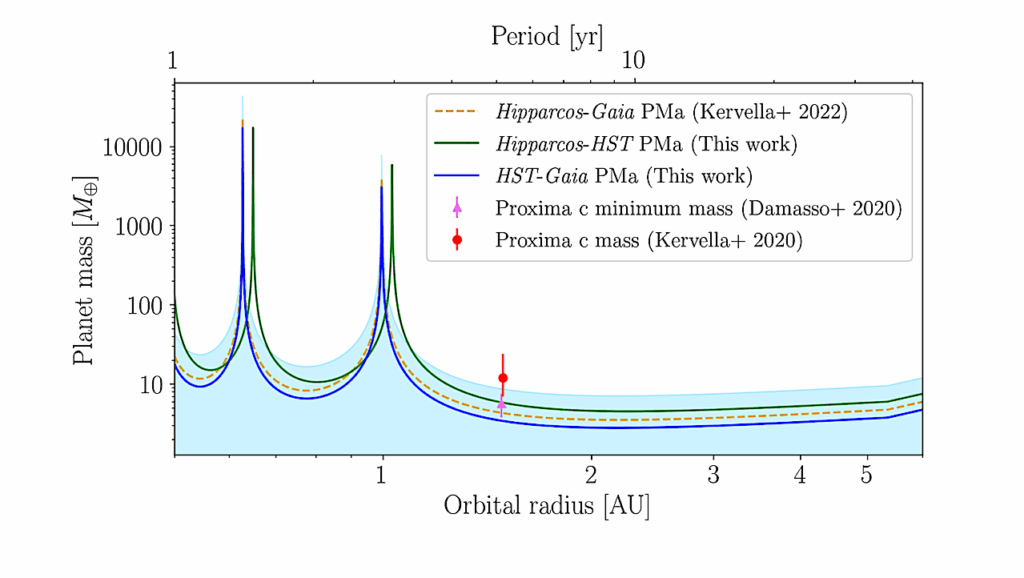Now Reading: A Model of UV-Blue Absorbance in Bulk Liquid of Venusian Cloud Aerosols Is Consistent with Efficient Organic Absorbers at High Concentrations
-
01
A Model of UV-Blue Absorbance in Bulk Liquid of Venusian Cloud Aerosols Is Consistent with Efficient Organic Absorbers at High Concentrations
A Model of UV-Blue Absorbance in Bulk Liquid of Venusian Cloud Aerosols Is Consistent with Efficient Organic Absorbers at High Concentrations


Comparison of glucose (itself non-absorbing) at different time points after its addition to 85% w/w sulfuric acid. The glucose reacts with sulfuric acid and produces rose-pink solution with a single predominant product (Love, 1953), which reacts further towards tar-like mixtures. Here 10 mM glucose in 85% w/w sulfuric was heated to 60°C for indicated time. The sharp defined peaks are gradually converted into a broad ramp with less defined peaks (dashed and dotted lines). Inset shows how the plotted progression towards tar-like mixtures appears visually. The glucose solution is colorless, but when exposed to sulfuric acid, within few seconds it turns rose-pink, followed by barely transparent brown (see the top of the meniscus) to completely opaque solution upon prolonged heating (hours). — astro-ph.E
At visible wavelengths, Venus appears serene and pale-yellow, but since the 1920s, observers have noted high-contrast features in the ultraviolet.
These features track the about 4-day superrotation of the upper cloud deck and vary widely over time and space. The identity of the UV absorber(s)-active between at least 280 and 500 nm-remains unknown, as no proposed candidate fully matches all observational data.
From remote observations of Venus, and accounting for light scattering by sub-micrometer droplets, we modeled the 365-455 nm absorbance per cm of the bulk liquids forming Venus’s clouds.
Assuming a uniform distribution in mode 1 and 2 particles across a 6 km layer below the cloud top at 65 km, we constrain the bulk absorbance with a peak at A375 nm being 2942 per cm. This extremely high absorbance implies the presence of a highly efficient absorber, most likely conjugated organics, at relatively high concentration-e.g. about 25 g/L for porphyrin type pigments.
Inorganic absorbers, with molar absorption coefficients typically in the range of 1,000-10,000 per M per cm, would either need to comprise a large portion of the aerosols or are simply not light absorbent enough, even if present in pure form.
We emphasize that all candidate absorbers must be evaluated against Venus’s reflectance curve using (i) known molar absorption coefficients, (ii) realistic atmospheric distributions, and (iii) appropriate particle size distributions. The upcoming Rocket Lab mission will test the hypothesis of organics in Venus’s clouds.
Jan Spacek, Yeon J. Lee, Paul B. Rimmer, Janusz J. Petkowski
Subjects: Earth and Planetary Astrophysics (astro-ph.EP); Geophysics (physics.geo-ph)
Cite as: arXiv:2505.00880 [astro-ph.EP] (or arXiv:2505.00880v1 [astro-ph.EP] for this version)
https://doi.org/10.48550/arXiv.2505.00880
Focus to learn more
Submission history
From: Jan Spacek
[v1] Thu, 1 May 2025 21:46:51 UTC (654 KB)
https://arxiv.org/abs/2505.00880
Astrobiology
Stay Informed With the Latest & Most Important News
Previous Post
Next Post
-
 012024 in Review: Highlights from NASA in Silicon Valley
012024 in Review: Highlights from NASA in Silicon Valley -
 02Panasonic Leica Summilux DG 15mm f/1.7 ASPH review
02Panasonic Leica Summilux DG 15mm f/1.7 ASPH review -
 03From Polymerization-Enabled Folding and Assembly to Chemical Evolution: Key Processes for Emergence of Functional Polymers in the Origin of Life
03From Polymerization-Enabled Folding and Assembly to Chemical Evolution: Key Processes for Emergence of Functional Polymers in the Origin of Life -
 04How New NASA, India Earth Satellite NISAR Will See Earth
04How New NASA, India Earth Satellite NISAR Will See Earth -
 05And Thus Begins A New Year For Life On Earth
05And Thus Begins A New Year For Life On Earth -
 06Astronomy Activation Ambassadors: A New Era
06Astronomy Activation Ambassadors: A New Era -
07SpaceX launch surge helps set new global launch record in 2024




















